The Outback’s Light Specialists
(Lead Photo by Andrew McAllister Imaging)
Ancient off-road wisdom warns not to travel after dark in the backcountry. Find camp early. Avoid the risks of mishap from animal strikes, trail obstacles and losing the trail. Etc.
But common wisdom is usually the first victim of reality. A breakdown delays arrival at that amazing (but elusive) campsite. We explore through the long nights of a northern winter. We find ourselves pounding miles of blacktop in equally inky darkness, having worked late and driven even later.
Like with most factory 4×4 engineering, OEM lights on even the best vehicles are aimed at meeting federal regulations from alphabet soup agencies (e.g., NHTSA, DMV ANSI), and not real-life adventure travel. Enter the free market and our industry’s enormous aftermarket of innovators. To meet this need, auxiliary light brands have exploded over the past decade, fueled by Asian knock-off’s of new bulb and reflector technologies.
In Australia, the 4×4 market has been evolving for decades. Manufacturers have created products out of necessity for the continent’s vast interior and its remote, almost entirely undeveloped northern reaches. For Australians who travel the Outback at high speeds on poor roads, spotting hazards is a matter of life and death. Emus, kangaroos, feral cattle and pigs, and even camels (1M inhabit Oz) are among the critters a vehicle can collide with.
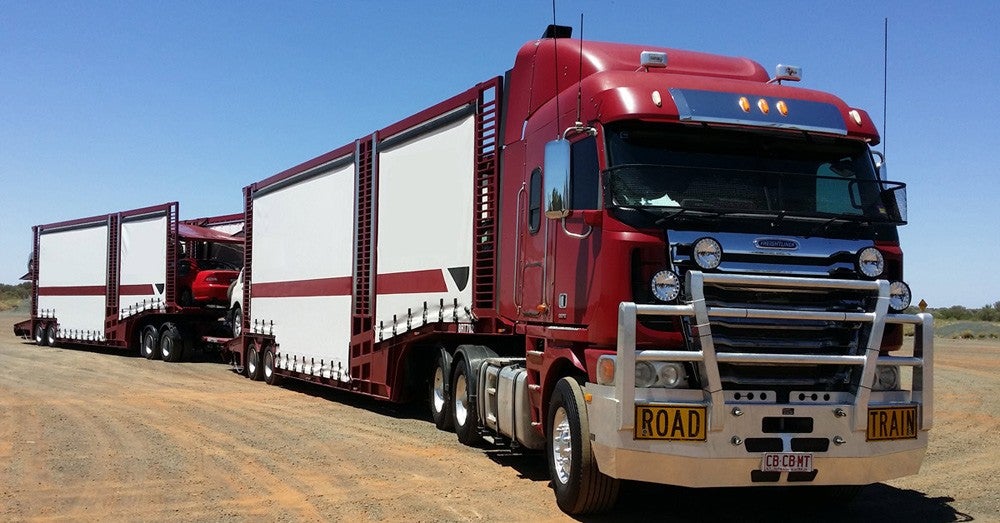
As a result, auxiliary lighting is hugely important Down Under. Born and still based in Australia, Lightforce Performance Lighting has been producing a wide range of lights for almost 40 years. Unlike most companies offering driving lights, Lightforce also provides handheld illumination solutions for hunting markets and those in law enforcement.
I first became aware of Lightforce when I was doing research on urban crime, and needed portable, reliable tools. Searching for infrared spotlights to use with night vision equipment, Lightforce stood out in the early 2000s for its lightweight, rechargeable spotlights and the clip-on filters they could be outfitted with. North American distribution of Lightforce was, and still is, based south of where we lived (Orofino, Idaho), but today the brand is better known for its powerful lighting solutions for vehicles.
Lightforce had first grabbed attention in N. American markets for the extremely tough but light Striker and Blitz halogens driving lights. Uniquely made with polycarbonate and fiberglass-filled nylon, the enormous lights earned a reputation among long-haul truckers from Alaska to the Uluru. Offering dozens of optional filters – each with distinct coloration and/or beam-altering patterns – to help customize the lighting type and distribution, Lightforce continues to build its line around helping users dial in their system through these uncommon accessories
Table of contents
Finding Kangaroos & Camp: Configuring Your System
To better understand its products, we asked Lightforce to solve three lighting problems. First, provide an evenly dispersed, 200-degree forward lighting area, with illumination that outdistances maximum rate of travel. Second, illuminate blind spots during backing by augmenting reverse lights on our Land Cruiser and on the matching Dinoot trailer it often tows. Finally, provide area lighting for specific tasks (e.g., food prep, underhood repair).
The first goal was clearly the highest bar. No single product can cast light from immediately to the sides of a vehicle, and also spread light evenly all the way out to a half mile (at least) down the trail. Brian Gearhart, Lightforce’s guru since the brand came to the States, took on the challenge, providing all the know-how and guidance for the system. Together we talked through the dream pattern that was envisioned. In the end, he proposed a trio of lights.
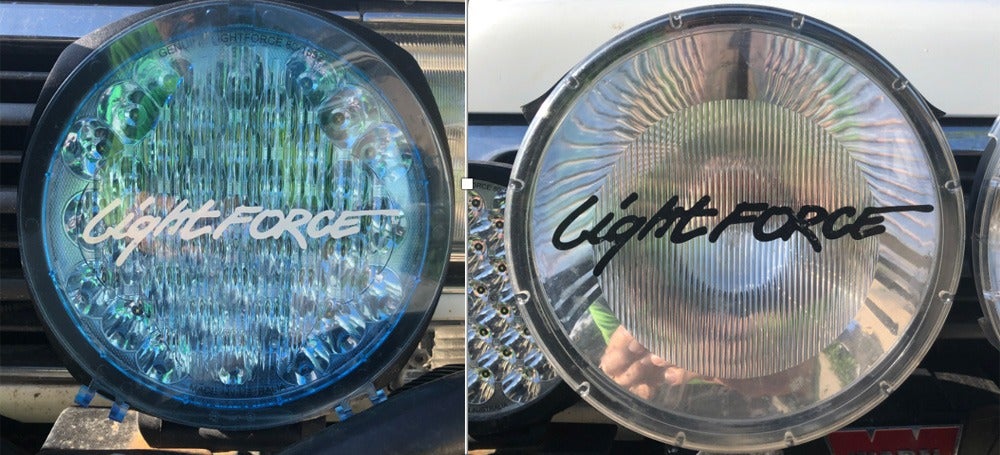
To see deer eyes (or a kangaroo’s) out to a mile, the race proven Lightforce XGT HID was Brian’s go-to. At nearly 10” in diameter, the XGT may be the largest offroad light currently available, and is tested to 1 lux performance at over 1200m. Relying on proven high intensity discharge (HID) bulbs, these massive lights draw only 50w, offer 4200K color, and yet are a svelte 3lb apiece. The lens produces a narrow driving “spot” beam, which is optimal for arrow-straight roads, but in other terrain can be overkill. For situations needing more broad light dispersal of that beam, Brian paired the lights with a set of clear Combo filters. These snap on polycarbonate filters are very tough, weighing only ounces but providing full protection from rock strikes, and have very secure attachment.
The second level of pattern infill came from the company’s next generation lights, which are built around the capabilities of LED bulbs. The U.S. Dept. of Energy credits GE engineer Nick Holonyak, Jr. with inventing the first visible-spectrum LED back in 1962. However, LED’s didn’t impact the automotive lighting industry until much later. Not until 2004 did the first production automobile, Audi’s A8 W12, feature LED running lights, and a year later that the Lexus LS 600h offered headlights (low beam only) powered by LEDs.
Lightforce released its first LED driving light back in 2014. Since then, the technology has enabled its lamps to claim 50,000hr lifespans. Effectively, they will never burn out, even if you drove from dusk to dawn 6,000 times. The practical advantages of LED’s far outweigh their staggering longevity. Their resistance to damage from incessant off-road vibration, instant-on full strength light (a big plus over HID’s, which require ballast warm-up), exceptional light color/quality, and versatile configuration (e.g., number and direction of reflectors) have made LED’s the dominant technology in Lightforce products.
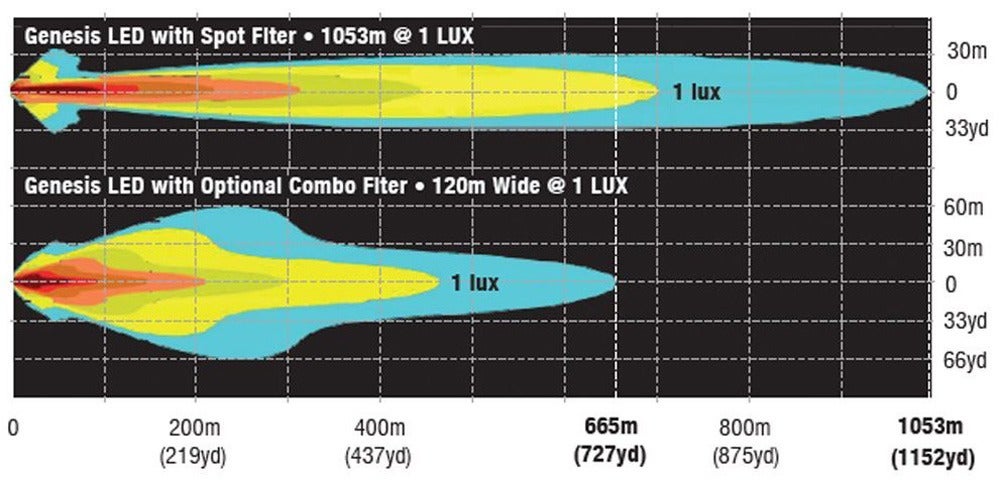
The just-released Lightforce Genesis was Brian’s recommendation for the core area of illumination. Casting a bright, white (5000K) swath from immediately in front of the vehicle and out effectively to ¾ of a mile, the 9” Genesis provides the base lighting, while the XGT stretches out even further (or wider, if the Combo filters are used). Also distinct is the depth required on your bumper by the Genesis. While the XGT takes up 7” of space from lens to back of housing, the Genesis requires less than 3”. This dimension on a light can be a deal maker/breaker for fitment on many bumpers.
When searching for camp, and not scanning for deer eyes way down the road, these huge output lights aren’t ideal. Widely dispersed, short distance, lower output lights tend to rule for the near distance viewing that overland travel frequently involves, such as crawling through rock gardens or scanning down a hidden spur trail. Lightforce offers several lens patterns for lighting proximate to the vehicle. But for maximum dispersal, the Lightforce ROK40 in Ultra Flood pattern reigns. Compact, tough (die cast aluminum body) and a low wattage draw (40w), these easily positioned “work lights” let you see all around.
The ROK40 series siblings, the ROK20 and ROK10, are built around correspondingly fewer LED chips, and are meant for applications needing smaller coverage areas. For illuminating the large blind spots rearward of our Toyota and its trailer, a pair of the ROK20s, also in Ultra Flood pattern, were wired into the existing wiring harnesses. Their 20w draw meant they didn’t overwhelm either truck or trailer wiring capacities.
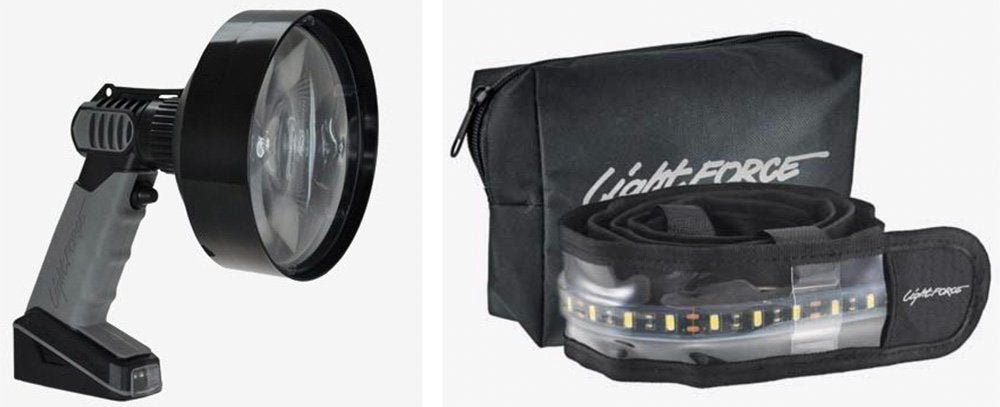
Lightforce’s traditional Australian approach to offroading – solutions for driving, camping and, yes, hunting/tactical – means the brand also offers several unique lights for other uses. In addition to the infrared-equipped Striker (halogen) I used for crime research, since 2018 I’ve also been using the updated rechargeable Enforcer (LED) spotlight. Its adjustable beam and light weight make it handy for scoping out potential camp sites or finding that owl hooting nearby. For lighting the camp kitchen or a trailside repair, their rollable, dimmable Flexible LED Strip is a better choice.
Upgrading Toyota’s OEM System
In addition to adding auxiliary lights, most vehicles can benefit from upgrading factory lighting. The lower draw/high output nature of LED’s has led to many aftermarket manufacturers. For Toyota’s reverse lights, we upgraded with PFRAN’s plug-n-play replacement bulbs [Note: their LED replacements for interior lighting are outstanding]. However, for headlights, the 80 Series headlights can be easily upgraded with an affordable 2-part solution.
First, Toyota used woefully inadequate wiring harnesses for the Cruiser’s headlights. Slee Offroad, which specializes in Cruisers, offers a 9005/9006 Headlight Upgrade Harness. The high-quality harness markedly enhances light output with OEM headlight bulbs, but more importantly allows the second solution: use of higher 65w bulbs. Better still, the Slee harness allows use of the Phillips and Wagner/Phillips’ halogen infrared (HIR) technology by adapting 9011/9012 bulbs.

Setup + Installation
Designing a safe, effective, durable auxiliary light system benefits from some planning. Light positioning affects pattern and distance, as well as vehicle maintenance, winch access, and protection from damage to the lights (e.g., animal strike, branches). Fitting six different lights – four of them quite large – on even a full-sized truck poses a challenge if factory lights aren’t to be impeded. We test fit over a dozen possible configurations before finding the right fit from all three dimensions.
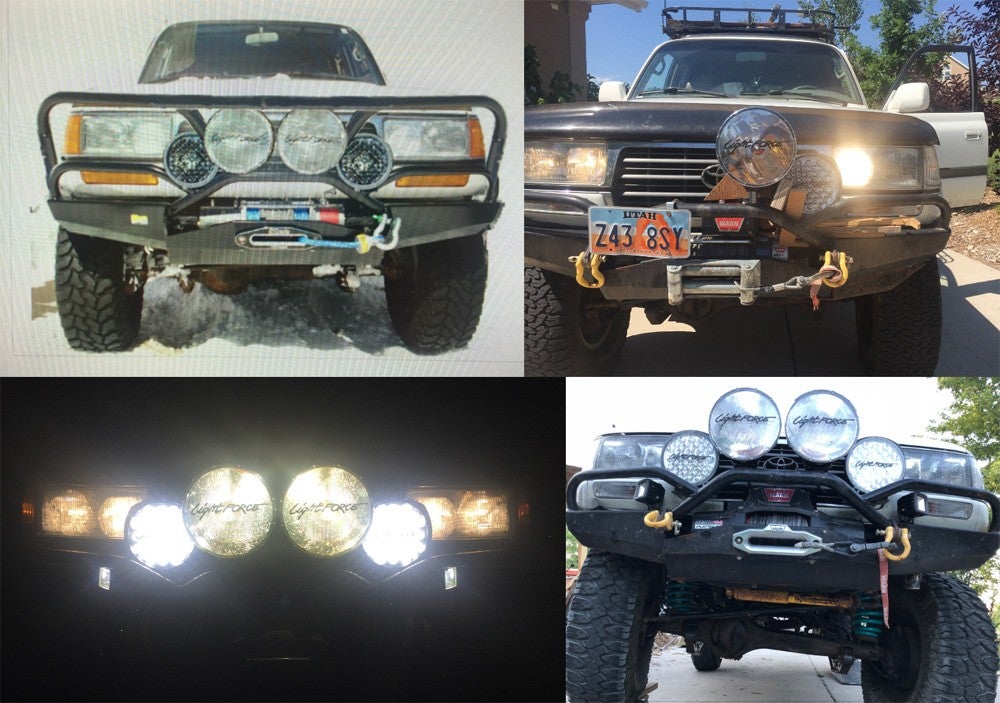
For the rear-facing ROK20 lights, their 90-degree light pattern offers plenty of mounting flexibility. Higher mounts, however, helped project light most broadly, and over obstacles that can block lights at the bumper or tailgate level. Additionally, the adjustments built into the ROK series makes them quick and easy to dial in.
For the other half of every light system – the wiring harnesses and switches – it helps to both mock-up routing/layout, and (for some of us) hire a professional. Beginning with positioning of switches for optimum ease of access when driving, it’s critical to consider with which hand and how far from the steering wheel the operator prefers to reach when suddenly wanting to kill the lights, such as facing oncoming traffic from around a turn.
Lightforce offers a variety of switches, which allow for either rocker or push-button operation. Our system is unique in that it combines a set of switches for the Genesis and XGT lights (console left of steering wheel) with the remote control for WARN’s Zeon 12-S Platinum.
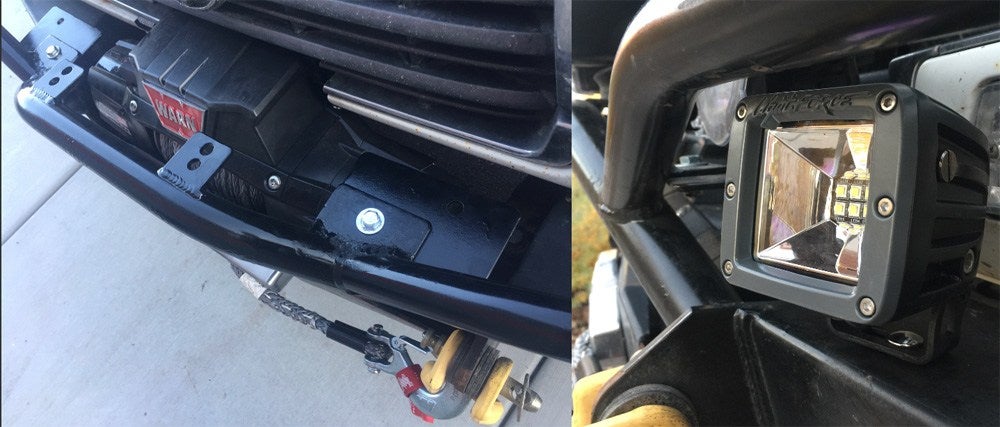
WARN created an industry-leading innovation by adding accessory power ports on the Zeon’s control unit. This means that only short runs of wire are needed, running from the Zeon to your lights. Because the lights are then operated via the wireless WARN remote control, which can handle two different sets of lights (15A max each), this configuration is best for area lights used when winching or going slow. We connected the ROK40 Ultra Floods to the Zeon for this reason.
On average, each set of lights required approximately two hours for a professional install of the wiring. In actuality, some of the systems were more complicated due to wire routing, switches (e.g., none required for reverse lights), etc. Mounting was similarly asymmetric for the time they took. To configure the big lamps, custom mounts and brackets were fabricated to attach them to the Slee ShortBus bumper.
Behind the Wheel
If you like stress, driving at night with inadequate lights is a recipe for pleasure. Many 4×4 vehicle manufacturers apparently think that’s the desire of buyers. Even the most modern vehicles throw sub-par light to both the front and rear. Toyotas aren’t unique in this flaw, and their older trucks were much worse.
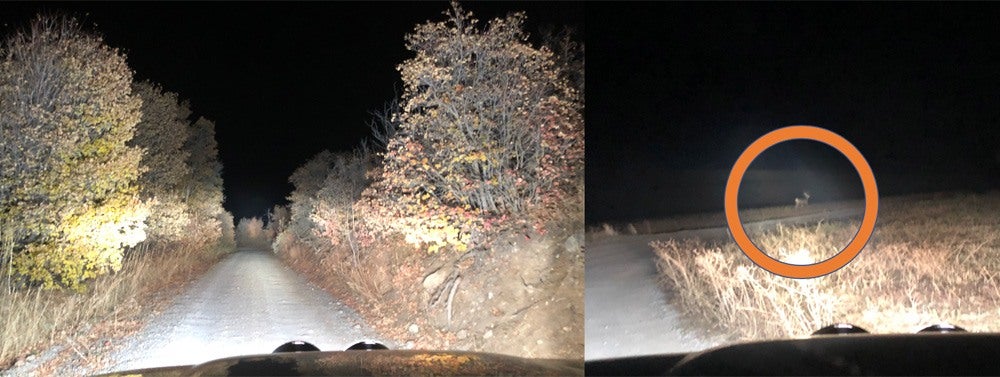
For the big 80 Series, the basic upgrade from Slee Offroad’s high capacity harness and bulbs offers a fair bang-for-the-buck. The Low beam in particular is boosted to a level similar to (and potentially better than) the factory High beams. The High beam, while not gaining so much, also clearly benefits. However, it’s no panacea for seeing far and wide into the inky night. For many, the Slee upgrade will be adequate, and for every 1991-97 Cruiser owner it will finally make in town night driving acceptable. Though still producing a slightly yellow color temp, even in rain the output is now reasonable.
The same is true for the light gains by the PFRAN LED bulbs. They make backing no longer a dodgy affair when parking. Ultimately, though, the proof is in your eyes. If they are still straining to see, then it’s still too dark. And there is no comparison between the light cast by a well-positioned 20w ROK20’s as a reverse light and 5w PFRAN replacement bulbs projected through factory taillights.
On the Cruiser and on the trailer, the ROK20 adds markedly to safety, and all from a light that measures ~2”x2”x3”. This is a no brainer in the Ultra Flood pattern. In fact, the only decision we would change is considering a second unit on the trailer, where backing angles can mean that a full 180 degrees of rearward visibility can be a must in tight woods. Similarly, under the Cruiser’s hood, the thin ROK10 transforms the blackness. While we found that ideally a pair of these or the ROK9 would be used (one affixed to the hood above each side of the engine bay), even a single light is a tremendous improvement.

The Lightforce ROK40 Ultra Flood is, not surprisingly, exactly twice the light of its smaller sibling. It differs by projecting that additional light not wider, but rather in the perpendicular direction. Hence, if you need to illuminate left to right in a 90-degree swath, but also 90 degrees from ground to treetops, the ROK40 is the choice. Our bumper-mounted pair were positioned to angle the light’s most outward edge slightly rearward on each side. This allows occupants to literally see directly to the sides of the vehicle.
For technical trails, looking laterally down side roads and similar, the ROK40s are a godsend. They’re instant-on via the WARN Zeon controller. Combined with factory headlights, they illuminate a 200-degree area of light out to about 40m. For after-hours, slow speed driving where choosing the route is critical, these little lights deliver in spades.
When you’re fully stationary, the Lightforce Flexible LED Strip is a handy area light. It’s just right for a camp kitchen, to light beneath a rooftop tent overhang, or to plug into a vehicle’s 12v plug to let you see a 10mm from a 12mm (or a pepper from a paring knife). With 18’ of cable it reaches a long way, but can be a bit much to keep from tripping over. Surprisingly, the entire system rolls easily into the provided zippered case for quick stowing/setup. We’ve used it in many camps, to partially light the interior of a 30’ yurt, and for emergency lighting in a power outage.
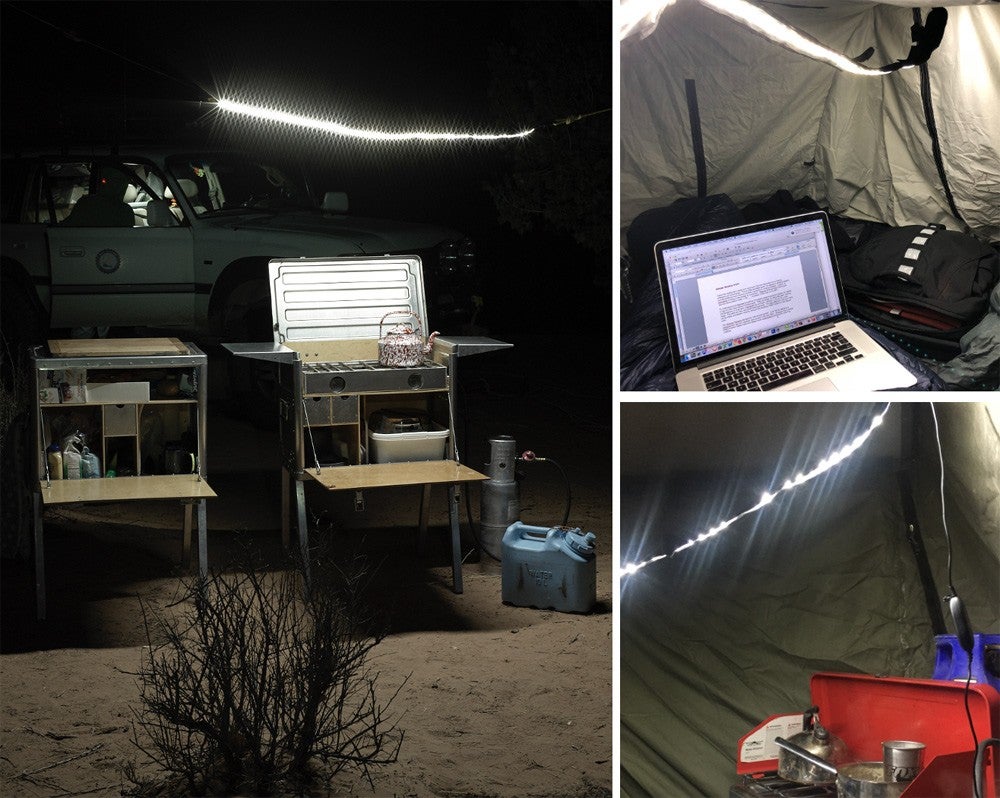
As much as those smaller lights are helpful in different situations, the main event in vehicle’s auxiliary lighting is projection that reveals what’s in the darkness far past the reach of factory headlamps. A deer? A sagging cattleguard? A downed tree or black void that hides…a washout???
Straining to discern what’s “out there” taxes any driver who routinely finds themselves plying the highways and byways and BDR’s past sunset. If you’re in this group, you know the feeling of tension, clinching the steering wheel, and continuously easing off the accelerator “just in case.” The Lightforce Genesis LED was created to let drivers relax, brightening hazards hundreds of meters before you reach it and, specifically, in time to brake, prepare to turn, or to just accelerate.
None of the Lightforce products has proven itself as valuable as the big pair of Genesis lamps. They offer a unique three-stage intensity option, allows users to opt for simple daytime running mode, or to choose from one of who night modes. Their real beauty though lies in the instant-on massive swath of usable light when in maximum output mode, listed as 13,000 raw lumens. When flipping the switch on, I’ve come to know the immediate sensation of my eyes and facial muscles relaxing as the road ahead is suddenly lit up.
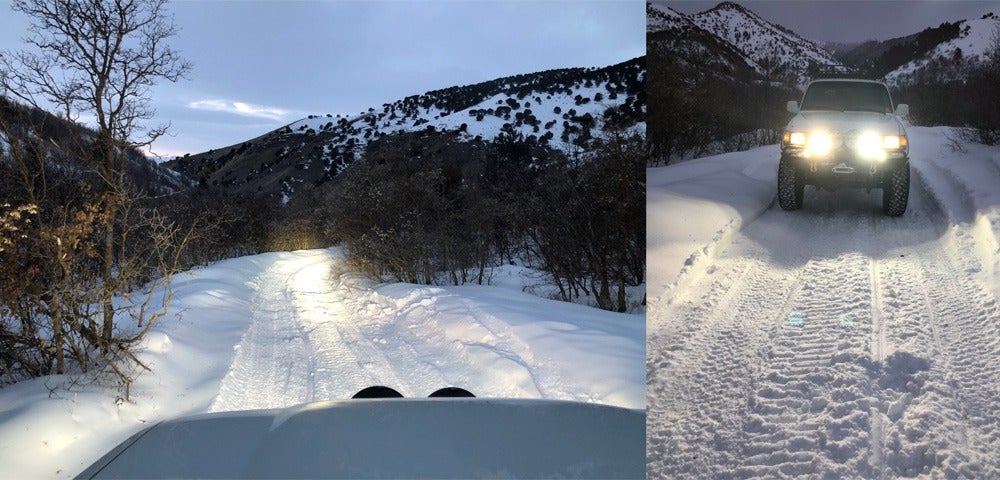
Compact in a fore/aft dimension, the Genesis departs from Lightforce’s traditional composite construction with its die-cast aluminum body. In most offroad driving, the Genesis lights won’t be “outdriven.” They simply light up the road too far. If you’re driving a Raptor or WRX and using it to its capacity, then, yes, the 1000m range of the Genesis may fall short. But for everyone else, the light has the power you need.
Designed around a relatively traditional “driving” pattern, Lightforce engineers gave the Genesis a useable near distance (100m) medium width light spread, along with punching out a lengthy bright corridor equivalent to the width of a two-lane plus well off the shoulders.
How lengthy? At 50mph a driver will have fully 25-30 seconds before they reach the effective limits of the illuminated landscape. The curve in the road, the tip-toeing doe, they appear now within a very comfortable range.
For some folks, “comfortable” isn’t soon enough. They want prescience. Even a divine omniscience of what lies ahead. Whether desert racers or tractor trailers needing a quarter mile to stop, the iconic Lightforce XGT was created. Debuting in 2001 atop the trophy truck of Baja racing legend Rod Hall, the XGT built on Lightforce’s experience in high output halogen lights, but with HID power.
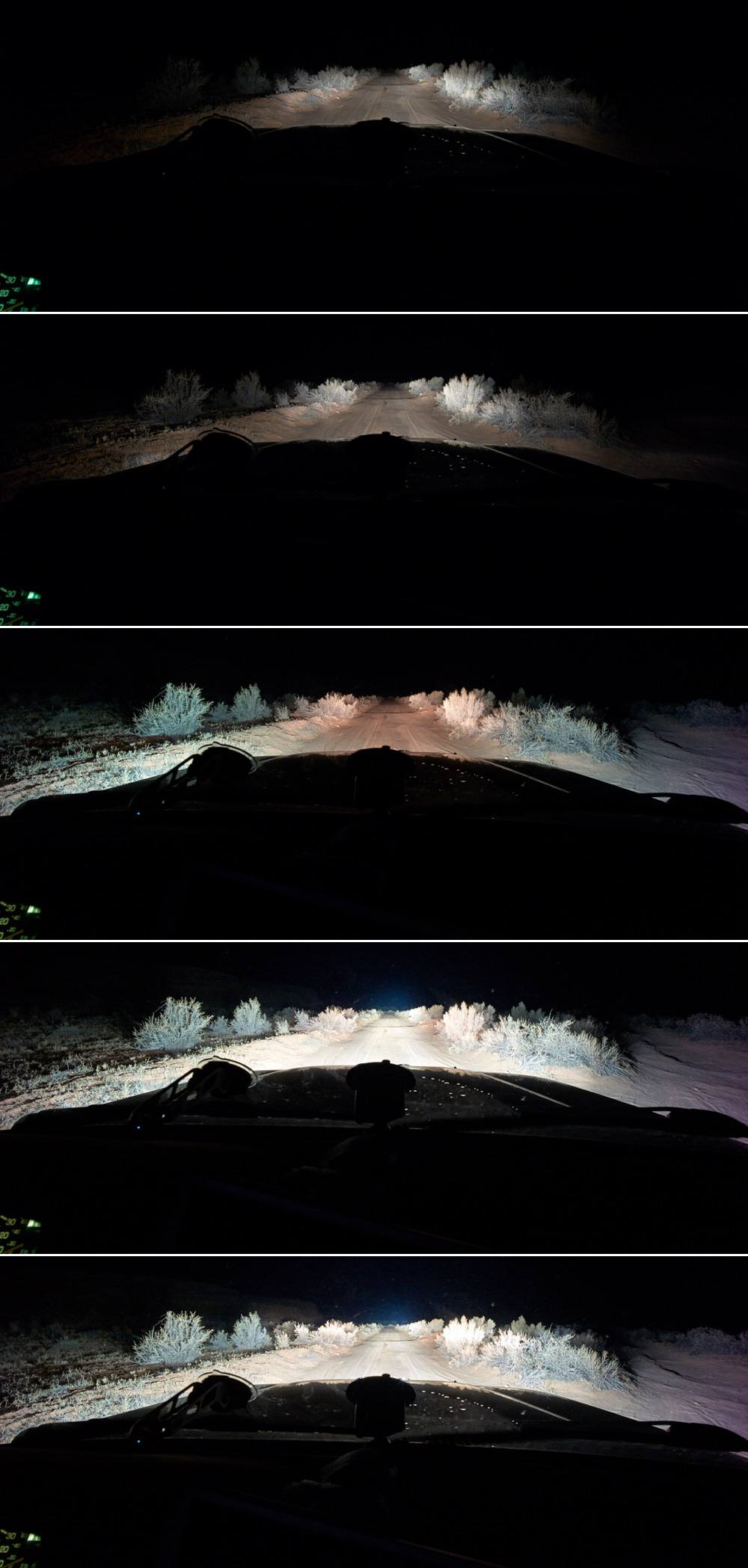
The light’s enormous reflector helps it reach nearly twice the distance of the Genesis. To do so, it projects a very precise, narrow beam (think kangaroo eyes glowing at a mile or more). For most of us, that narrow mean also translates into narrow benefits, and not just for our lack of marsupials. However, Brian’s inclusion of the Combo (clear) filter transforms the XGT’s pattern.
The light’s 4600+ raw lumens are redirected with the Combo filter, pulling them back and out. By no means short in the resulting cast pattern, the usability is much better. They spread out laterally in a precise beam that, when combined with the unfiltered Genesis, makes for a massive area of light that stretches 50m out from the sides of the roads, as well as way, way out in front. Nonetheless, the pattern can be too much light. For plenty of trail driving, the ROK40 with the Slee High beams are sufficient.
The hue of the two lights is not identical. HIDs cast a slightly bluer light, whereas the Genesis is very pure and white. The combination is actually effective, and not a contrast or unpleasant. This may explain, in part, why the latest release from Lightforce is the unprecedented LED/HID blend within a single light, the HTX2. The HTX2, and the prior HTX, “hybrid” light design may hint at a blending of technology to come for Lightforce, and perhaps others.
Our Final Verdict
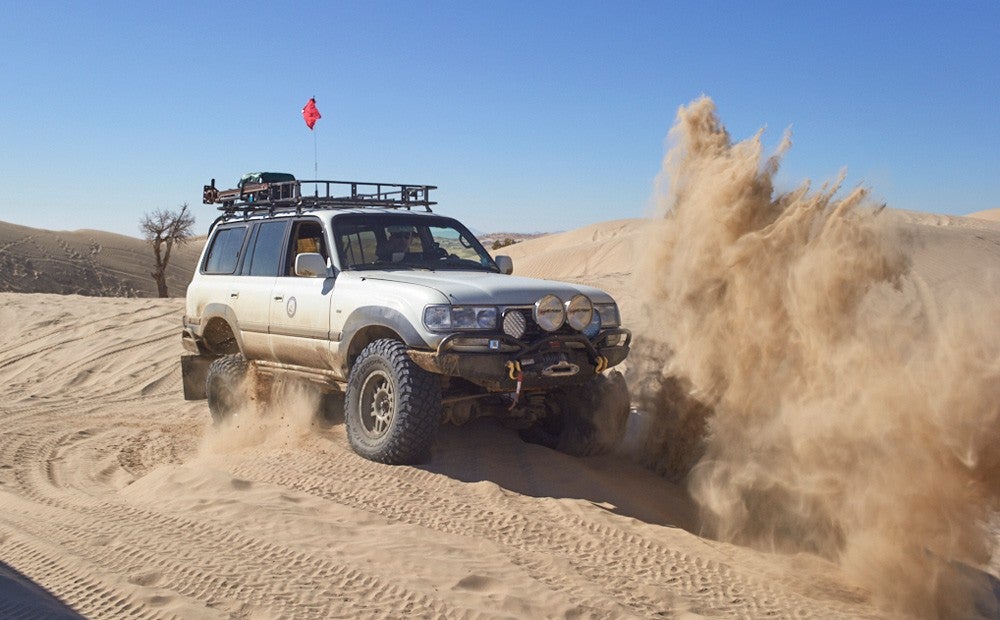
Although we’ve not yet had a chance to test the latest award-winning HTX2, what is clear is how well each of the tested lights have held up, and their delivery on the promised output and patterns. While each model is unique, and meets a very different need, all have performed as claimed. Durability has proven to be a strength of all the Lightforce products we tested. The condition of their housing and their lenses have exhibited zero wear/degradation/discoloration in over two years of operation. Their IP69K water resistance rating has proven adequate to keep each light free from interior moisture, despite year-round outdoor usage and storage.
In fact, there has been zero breakdown in finish or components of any of the tested products. For consumers looking for that kind of reliability, lights from a long-standing industry leader, Lightforce offers the N. American market a lineup that mixes incremental refinement of race-proven products with innovations in technology. Built for the Outback, they’re also up for demanding usage anywhere around the globe.
About the Gear Doctor: Dr. Sean Michael has been designing, abusing and testing outdoor gear since the 1980’s, and began reviewing products for Off-road.com in 2000. Today, he is Professor of Outdoor Product Design & Development at Utah State University, a product consultant, and a frequent Instructor at Overland Expo. Follow his trips and gear (ab)use @thegeardoctor on Instagram.
We are committed to finding, researching, and recommending the best products. We earn commissions from purchases you make using the retail links in our product reviews. Learn more about how this works.
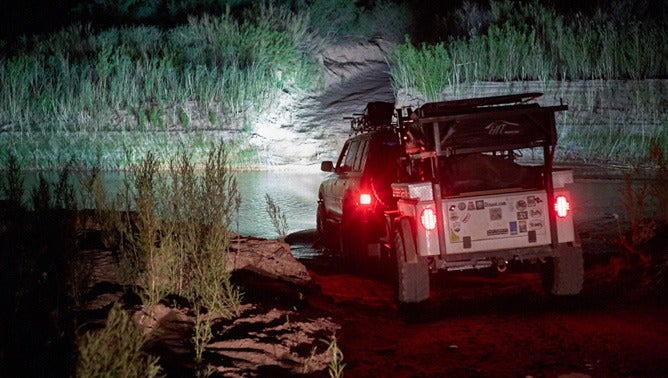

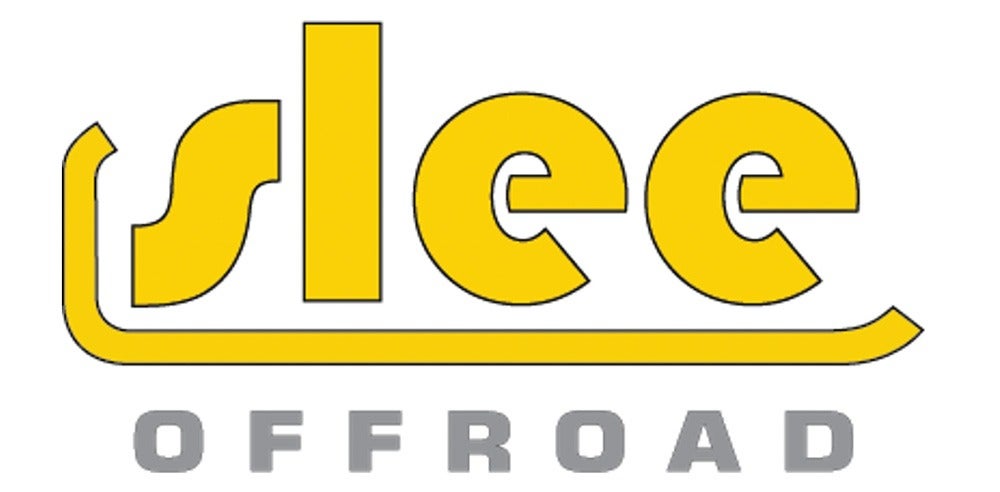
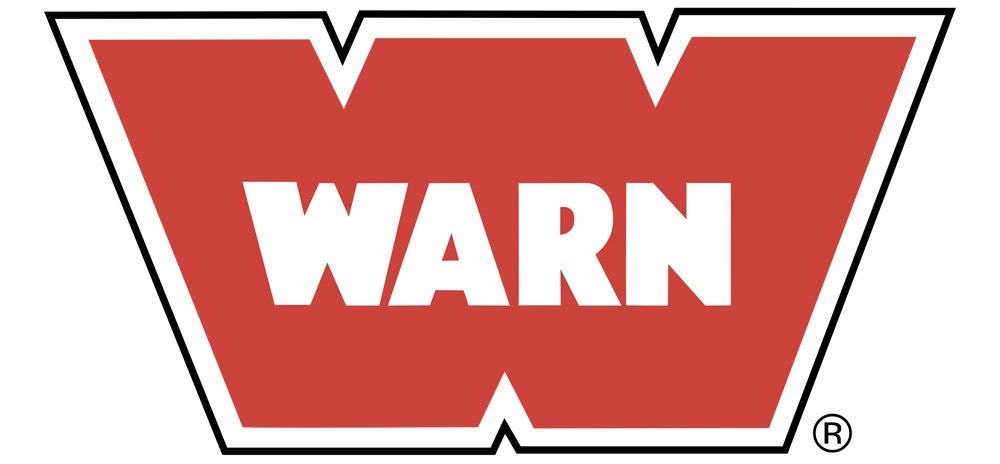

 Your Privacy Choices
Your Privacy Choices